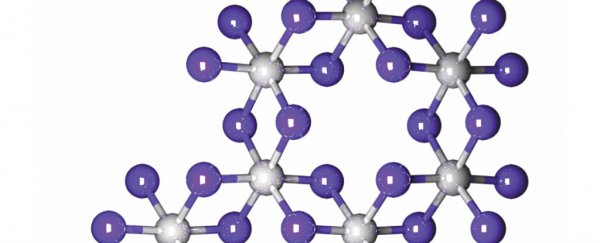Since the discovery of graphene in 2004, there's been a proliferation of strange new two-dimensional materials. In all of them, scientists have been chasing one invaluable property - magnetism, which is crucial for data storage, medical devices, and electricity generators.
After years of searching, many suspected that true two-dimensional magnets might not actually exist. But now we finally have proof - physicists have created the first ever 2D magnet, and it's got properties we haven't even seen yet.
"What we have discovered here is an isolated 2D material with intrinsic magnetism, and the magnetism in the system is highly robust," says one of the team, Xiaodong Xu from the University of Washington (UW).
"We envision that new information technologies may emerge based on these new 2D magnets."
In lieu of any true two-dimensional magnets up to this point, scientists have been figuring out how to magnetise two-dimensional materials by 'cheating' - adding holes or bumps into the atomic structure to sacrifice the 2D properties in some areas in return for magnetism.
But what if we could retain both properties at the same time?
Xu and another physicist, Pablo Jarillo-Herrero from MIT, were both separately chasing this goal, but decided to team up last year because of how important it would be for physics to prove that two-dimensional magnets were actually possible.
"It's a matter of principle - there is a big thing missing," Jarillo-Herrero told Katherine Bourzac at Science.
They decided to focus on a compound called chromium triiodide (or CrI3), because it's ferromagnetic in its three-dimensional form - a property that sees the 'spins' of its electrons align in the same direction, even without being exposed to an external magnetic field.
You can think of it as having its own internal magnetic field instead. Refrigerator magnets are also ferromagnetic in three-dimensions.
Chromium triiodide is also easily reduced to two dimensions via the 'Scotch tape method' - using adhesive tape to peel off layer after layer until it's just one atom thick.
But what would happen to its intrinsic properties once physicists started messing with its dimensional structure was anyone's guess - even the most fundamental properties can appear and disappear when you start stripping away atomic layers.
In fact, until now, no three-dimensional magnetic material has managed to retain its magnetism when cut down to two dimensions, so it was not clear if chromium triiodide would be the answer everyone's been looking for.
"You simply cannot accurately predict what the electric, magnetic, physical, or chemical properties of a 2D monolayer crystal will be based on the behaviour of its 3D bulk counterpart," says one of the team, UW's Bevin Huang.
Once they'd stripped down a one-atom-thick slice of chromium triiodide, the researchers tested its magnetic properties by shining a beam of polarised light at its surface.
If it was still magnetic, the aligned spin of its electrons could be detected in the reflection of the beam, and sure enough, that's what the team found - the first definitive proof of magnetism in a uniformly 2D material.
As Bourzac explains for Science magazine, things started getting weird when the researchers progressively added layers back to their two-dimensional samples:
"They also discovered that a two-layered sheet of this material isn't magnetic, but when a third is added the substance becomes a ferromagnet again. The material remains magnetic if a fourth layer is added, but gains other properties the researchers say they're still investigating."
And this is just the beginning.
Not only could this lead to slimmer electronics than ever - the team also suspects that when they start stacking multiple two-dimensional layers of chromium triiodide into so-called heterostructures, even stranger properties will emerge.
"There, you can get even more exotic phenomena not seen in the monolayer alone or in the 3D bulk crystal," Xu says in a press statement.
"Heterostructures hold the greatest promise of realising new applications in computing, database storage, communications and other applications we cannot even fathom yet."
The research has been published in Nature.
